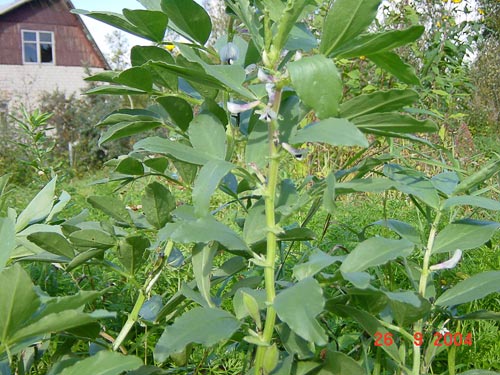Crops
Vicia faba L. - Horse bean.
Synonyms.
Faba vulgaris Moench, Faba bona Medik., Faba equina Medik.Taxonomic position.
Family Fabaceae Lindl. S. str. (=Papilionaceae Giseke), Tribe Vicieae Bronn (=Fabeae), Subtrib. Fabinae (Viciosae Alef.), genus Faba Mill.Biology and morphology.
2n=12. Annual plant. Taproot is strongly branched, penetrates to a depth of 80-150 cm. Colonies of nodule bacterium, which enrich soil with nitrogen, are formed on the roots. Stalk thick, strong, upright, bare or slightly pubescent, tetrahedral, hollow, 10-150 (200) cm tall, branching only at base. Leaves paripinnate, large, pulpy, without tendrils (the axil of leaf ends with soft cusp); with 1-4 pairs of leaflets, 4-8 x 2-4 cm, elliptical, glaucous-green (with a waxen bloom), bare; stipules up to 2 cm long, ovate-triangular, dentate, with nectaries. Peduncles 0.9-3 cm long. Flowers large, up to 3.5 cm long, 2-6 (12) per cluster. Calyx tubular, bare. Corolla white or pinkish with violet veins, spathes with a black maculae. Self-pollinator, but sometimes cross-pollinated. Fruit is a bean with 2-4-8 seeds. Beans very large, 5-10 (35) x 1.5-4 cm, oblate, cylindrical or oblong-cylindrical, pulpy, short pubescence, with bare sutures, green color when young, brown and black color when mature, coriaceous, on 1-4 in axil. Seeds 0.5 to 4 cm long, usually flat, oval, with lateral, pressed elliptical or linear scar, dark violet, red-brown, light yellow or green in color. The beans are differentiated by size: large seed grade (weight of 1000 seeds is 800-1300 g), middle seed grade (weight of 1000 seeds is 500-700 g) and small seed grade (weight of 1000 seeds is 200-450 g). Large seed grade is cultivated as a vegetable.Distribution.
Does not occur in the wild. It was grown in ancient times (cultivated for 2-3 thousand years), but only by purposeful cultivation. In Russia, it has been cultivated since the 6th to 8th century. In the USSR, it was cultivated as basic fodder almost everywhere, but the cultivated area was not large (around 20 thousand hectares). The greatest areas of cultivation are in Byelorussia and Ukraine, the Baltic states, and the Altai region.Ecology.
Horse bean does not require much heat and is cold-resistant (shoots tolerate frosts to 4-5°C). Plant requires long days to flower. Requires moisture, especially during germination and flowering. It does not tolerate stagnant water. Prefers clay and loamy fertile soils with neutral or sub-acidic pH levels and high water-retention ability. Vegetation period lasts 95-140 days. The combined temperatures of days above 10°C must be about 1900°C, as this is necessary for middle-maturing grades. The most widespread fodder varieties are: Korichnevye, Pikulovicheskie 1, Uladovskie fioletovye, Fioletovyi bobik, Aushra-22, Khorostovkie, Akkerperle, Primus, Istok, Orletskie, Penzenskie 16, and Herts Freya. Early ripening varieties, such as Mikko and Ukko (the Finnish selection), are recommended for northwestern Russia and Estonia. In favorable conditions, yield of seeds can reach 3.5-5 tons per hectare; dry vegetative mass, 10 tons per hectare; and green mass, 25-30 tons per hectare.Economic value.
Horse beans are used as forage for cattle (seeds, green mass, silo) and as a green fertilizer. Seeds contain 28-35% protein, 0.8-1.5% fat, 50-55% starch, and 3-6% cellulose. 1 kg of green mass contains 21 g digestible protein, 2 g calcium, 0.5 g phosphorus, and 20 mg carotene. Content of protein and fat of beans and vegetative mass combined is more nutritious but also more coarse than that of oat straw; therefore, it should be crushed before feeding. Beans mowed during flowering provide feeding hay. Beans are used not only as a fodder but also as a food in Transcaucasian countries and in Tadzhikistan. Bean is a good honey plant.Literature cited.
Chekanova, N.I., Kostrov, P.I. 1963. Technology of fodder beans cultivation. Moscow [In Russian].Edelshtein, V.I., Ushakova, E.I. 1960. Pea, bean, string bean. Moscow [In Russian].
Grain pod-bearing plants. 1960. Moscow [In Russian].
Korenev, G.V., Podgornyi, P.I., Zherbak, S.N. 1990. Plant growing with basis of selection and seed growing. Moscow [In Russian].
Niklyaev, V.S., ed. 1990. Basis of agriculture and plant growing. Moscow [In Russian].
Rep'ev, S.I., Stankevich, A.K., eds. 1999. Cultural flora. Vol. IV, part 2. VETCH. St. Petersburg, P. 38-42 [In Russian].
Fodder bean. 1988. Intensive technology. Ed. By I.V. Trubnikova. Moscow [In Russian].
Vehov, V.N., Gubanov, I.A., Lebedeva, G.F. 1978. Cultural plants of the USSR [In Russian].
Zhukovskij, P.M. 1971. Cultural plants and their relatives. Leningrad [In Russian].


